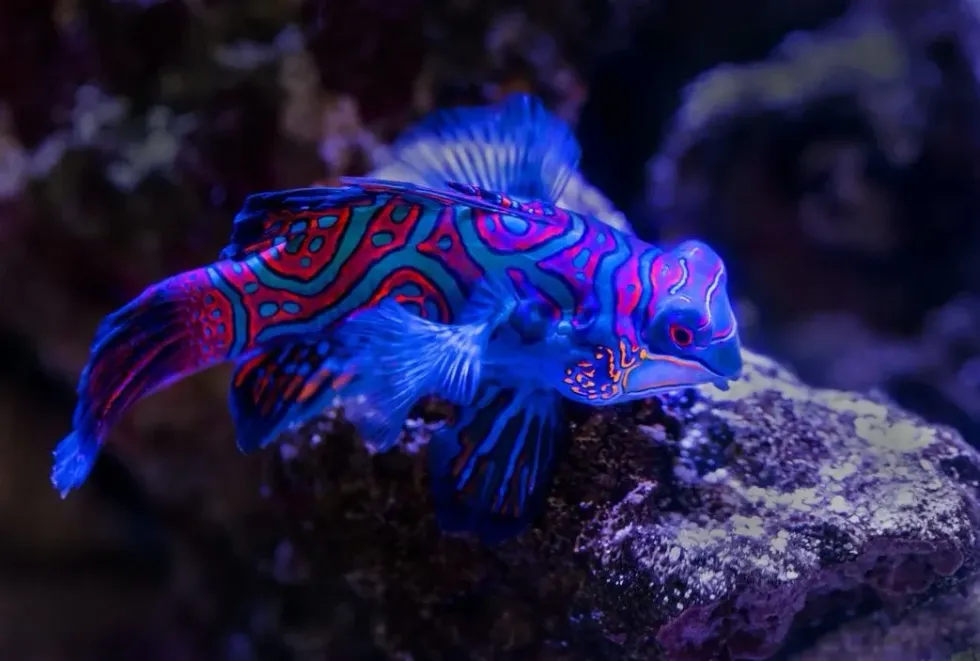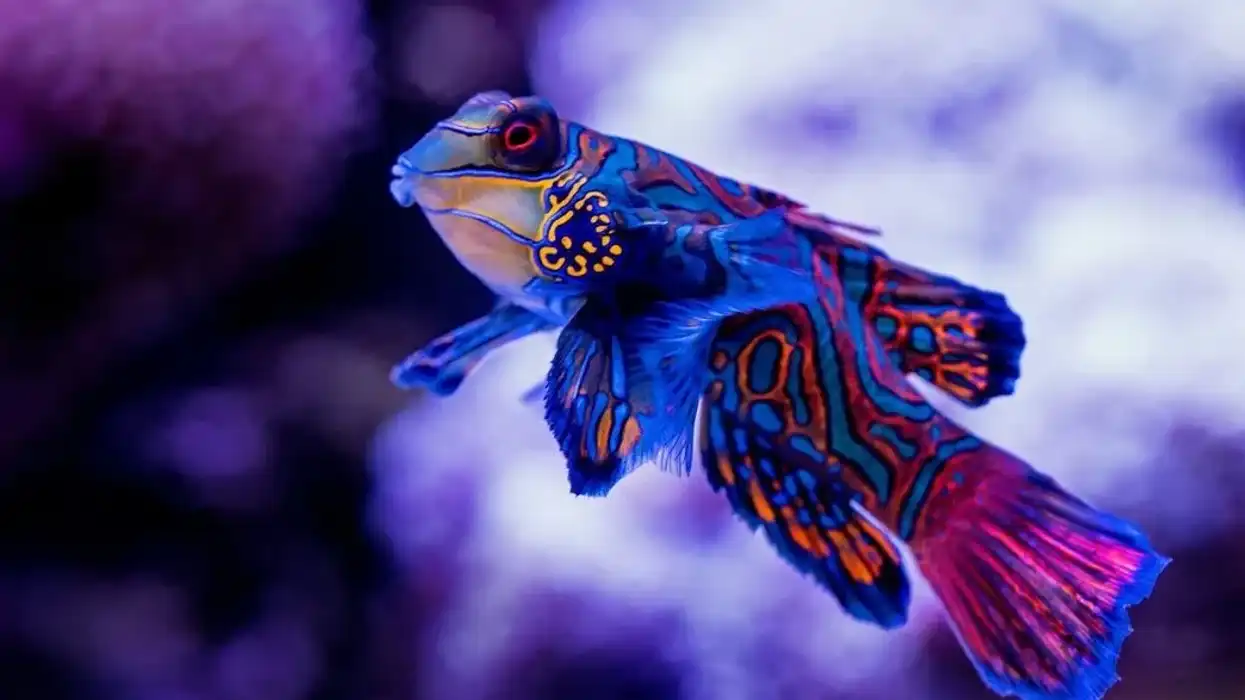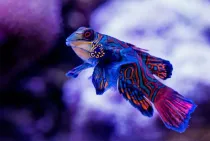Fun Mandarinfish Facts For Kids

If you like learning about different kinds of fishes, then this unique saltwater fish will definitely interest you. The Mandarinfish is one of the most attractive-looking fishes.
The most unique feature of this fish is the intense coloration. To add to its uniqueness, this fish has a rather unusual-shaped body.
Mandarinfish goes by many common names like Mandarin goby and Mandarin dragonet. It is native to the Pacific Ocean but is found in aquariums in quite a few parts of the world.
It is a common fish in the trade market and thus falls victim to fishing. The International Union for Conservation of Nature or the IUCN has listed them as Least Concern in their Red List so, there is no threat to the fish's population as of now.
This fish can also reproduce in great numbers which keeps their population in check. Keep on reading to know how this fish gets its vibrant color and more interesting facts.
To learn amusing facts about other species, check out the white cloud mountain minnow and sea snake.
Mandarinfish Interesting Facts
What type of animal is a Mandarinfish?
The Mandarinfish or Mandarin goby is a type of saltwater fish. This fish is a member species of the family Callionymidae.
What class of animal does a Mandarinfish belong to?
The Mandarin goby belongs to the Actinopterygii class of Animalia kingdom. It falls under the phylum Chordata and subphylum Vertebrata. This fish is a species with the genus Synchiropus.
How many Mandarinfish are there in the world?
The Mandarin dragonet is one of the 188 members of the dragonet or the Callionymidae family. They are primarily saltwater fish but can be found in aquariums in many parts of the world.
Since these species are bred in both wild and in captivity, it isn't easy to estimate their population. Hence, the exact number of Mandarin dragonet living in this world is unknown.
Where does a Mandarinfish live?
These blue-colored fishes are native to the Pacific Ocean. A Mandarin fish resides in the western Pacific in parts of Asia, China, and Japan.
In Asia, they are found in the Republic of the Philippines and Indonesia. Hong Kong and New Guinea also experience their presence in decent numbers. The geographic distribution of the Mandarin fish ranges all the way to the Ryukyu Islands in Japan.
What is a Mandarinfish's habitat?
The natural habitat of a Mandarin fish is tropical marine water. It prefers to stay near shallow lagoons and inshore reefs. Mandarin is noticed mostly dwelling at the bottom of the ocean. However, it tends to float up during spawning.
Who do Mandarinfish live with?
Mandarin fish are often seen in pairs or groups. A school of Mandarin goby is found on and near the coral reef looking for food. However, these species of fish are quite shy.
A Mandarin goby looking for food alone is not an uncommon situation. In an aquarium, a Mandarin will resent the presence of another fish of the same species, especially if they are males. Males show aggressive behavior towards each other and won't tolerate each other's presence in the same aquarium.
How long does a Mandarinfish live?
The average lifespan range of a Mandarin fish living in the wild is somewhere between 10-15 years, which is fairly long for a fish. However, it is observed that these species live a much shorter life in an aquarium.
Mandarin fish are relatively picky eaters, and they need very specific types of food to survive for long periods. Since it is difficult to incorporate this food into their diet, Mandarin fish do not live more than two to four years in captivity.
How do they reproduce?
The mating process of Mandarins is exceptionally interesting. Mandarins look extremely attractive with their bright blue color.
To add to this beauty, the males of this species engage themselves in a glamorous dance to attract the females. The females assemble to observe this enticing performance. This generally happens after sunset.
Not all females would be interested in mating and would simply swim away. The remaining ones accompany the males to their performance.
Due to the lower number of active females, the males are quite aggressive towards each other and compete to mate. They swim above the coral reef to spawn, with the female resting on the male's pelvic fin.
After this point, the mating process is similar to that of most fishes. A polygynandrous mating system is followed, and external fertilization takes place. The males release their sperm, and the female fishes release their eggs in the water simultaneously.
A female can spawn almost every night but can choose not to. It can release about 200 eggs in a single night which results in the rapid growth of their population.
Mandarin fish can be bred in captivity as well. However, the breeding needs to be done under the supervision of an experienced and reputable breeder.
Not all fishes of the same kind are compatible to mate with each other. Trial and error methods can be followed, but there are obvious chances of failure. Mating between fishes that have already mated in the past is easier but getting such a pair is quite expensive.
What is their conservation status?
The Mandarinfish (Synchiropus splendidus) has the status of Least Concern in the International Union for Conservation of Nature or the IUCN Red List of Threatened Species. These blue-colored species breed both in the wild and in captivity in large numbers.
In the wilds, Mandarin goby reproduces throughout the year. It is said that they can double up their population within 15 months. So, it is safe to assume that their population is not at any risk at the moment.
Mandarinfish Fun Facts
What do Mandarinfish look like?
The Mandarin is an interesting look fish with its depressed head and unusual shape. The most distinct feature of this fish is its vibrant coloration.
It is a blue-colored fish with wavy lines and patterns of various colors like yellow, orange, red, and green. The difference between a green Mandarinfish and a red Mandarinfish is that the latter has a red pelvic fin instead of the usual orange.
This fish lacks scales and anal spines. The main structural difference between the two genders of this fish is the presence of the elongated first dorsal spine in the males.

How cute are they?
The Mandarin is one of the only two fishes with this vibrant coloration. Its coloration, along with its unusual small-sized body, makes it look extremely attractive. It looks absolutely gorgeous while performing the courtship dance.
How do they communicate?
The Mandarin secretes toxins that drive away predators and competitors. While mating, it takes the help of motion in the form of dancing to call for potential mates.
How big is a Mandarinfish?
A Mandarin is a relatively small-sized fish. Its body does not grow more than 2.4 in or 6 cm.
Sexual dimorphism is observed in this species, and as a result, the males are somewhat bigger than the females. When compared to other marine fishes, the body size of a Yellow Tang is almost three times bigger than a Mandarin. Whereas a Longspine Cardinalfish is slightly smaller than an adult Mandarin.
How fast can a Mandarinfish swim?
Mandarin fish can be characterized as slow and shy. It spends the majority of its time at the bottom looking for food. Even in a marine reef aquarium, it is not found to be extremely active. It is evident that this fish is not a fast swimmer, but its exact speed is not known.
How much does a Mandarinfish weigh?
Mandarins are small-sized fishes with females weighing less than males due to sexual dimorphism. However, the exact body mass of Mandarins is not known.
What are their male and female names of the species?
The Mandarin fish does not have any specific name for the males and the females. They are referred to as male Mandarin fish and female Mandarin fish.
What would you call a baby Mandarinfish?
A baby Mandarin fish is referred to as fry.
What do they eat?
When it comes to food, the Mandarin fish is quite picky. It follows a very specific diet and will not just consume anything.
The Mandarin fish is carnivorous in nature. A school of Mandarin fish is often noticed in the bottom looking for food.
Most of their diet consists of crustaceans. Isopods and amphipods are some of the most preferred crustaceans of these predators. Live rocks support the lives of these crustaceans, and for this reason, Mandarins are mostly seen near the coral reef and other live rocks.
Apart from that, these predators also consume protozoans and various small worms in a decent amount. A good portion of their diet also includes eggs of other fishes and other marine animals found near the reef.
Even in captivity, this fish needs a proper diet. It generally refuses to eat normal fish food or prepared food. Feeding them might get a bit tricky.
Maintaining the aquarium with reefs and other live rocks is extremely important. Small crustaceans would be the perfect item to feed your pet Mandarin fish. Mandarins eat throughout the day, so it is crucial to provide them with adequate food.
Are they eaten by humans?
Mandarin fish is not the most preferred fish to consume, but people do consume them in some parts of the world. One of the reasons for this fish not being a popular delicacy all over the world is its smell.
Before cooking, the fish is left in the open for a couple of days for the smell to go away. After fermentation, the flesh of the fish has a texture similar to that of a garlic clove.
At this stage, it develops a classic flavor and tastes quite unique. Shallow firing the fillet and braising it in soy sauce is one of the most popular ways of eating this fish.
Would they make a good pet?
The Mandarin is a popular aquarium fish. The vibrant color and its small size have gained Mandarin fish a good place in the fish trade market.
They are quite easily available in a pet shop or online and have an affordable price range. However, a few things should be remembered before becoming an owner of this fish. A reef aquarium is required to make this fish feel at home.
Since it is a small-sized fish, the tank size is not an issue. It is mostly shy and passive but can be kept with other kinds of fishes.
Although a male does not get along much with its own kind, a pair of male and female can be kept in a tank together. The only challenge faced by the owners would be feeding the fish.
A specific and adequate diet needs to be followed. Once this diet is figured out, it is moderately easy to maintain a pet Mandarin. Weekly water change works just fine for it.
It is a fairly healthy fish but sometimes can fall sick. If there's a sudden change in the color or diet of the fish, it is wise to get it checked.
Did you know...
The Mandarinfish (Synchiropus splendidus) is a close relative of the Psychedelic Mandarinfish (Synchiropus picturatus). Both Synchiropus splendidus and Synchiropus picturatus have a prominent blue color. The reason behind this bright color is the cyanophores produced by Synchiropus splendidus and Synchiropus picturatus. Cyanophores are light-reflecting cells with bright blue pigments.
Is Mandarinfish poisonous?
Mandarin fish secret mucus that makes their body slimy and stinky. This coat of mucus is quite toxic and can cause serious harm to predators. This is the reason Mandarin fish has no known predators.
Habitat of the Mandarinfish
The natural habitat of this reef fish is in the tropical waters. Mandarins can be seen at a depth of 59 ft underwater, and the preferred temperature is between 75-79 F. They swim about 3 ft upwards while spawning.
In captivity, a 30 gal aquarium is good enough for one Mandarin. The aquarium needs live rocks for the fish to survive.
Here at Kidadl, we have carefully created lots of interesting family-friendly animal facts for everyone to discover! Learn more about some other fish from our Triggerfish facts, and cherry barb fun facts pages.
You can even occupy yourself at home by coloring in one of our free printable mandarinfish coloring pages.
We Want Your Photos!
More for You
See All
Bachelor of Arts specializing in Journalism and Mass Communication, Postgraduate Diploma in Sports Management

Moumita DuttaBachelor of Arts specializing in Journalism and Mass Communication, Postgraduate Diploma in Sports Management
A content writer and editor with a passion for sports, Moumita has honed her skills in producing compelling match reports and stories about sporting heroes. She holds a degree in Journalism and Mass Communication from the Indian Institute of Social Welfare and Business Management, Calcutta University, alongside a postgraduate diploma in Sports Management.
Bachelor of Law

Abdulqudus MojeedBachelor of Law
A versatile professional with a passion for creative writing and technology. Abdulqudus is currently pursuing his Bachelor of Law from the University of Lagos and has experience as a tutor, intern assistant, and volunteer. He possesses strong organizational skills and is a detail-oriented person.
Disclaimer
1) Kidadl is independent and to make our service free to you the reader we are supported by advertising. We hope you love our recommendations for products and services! What we suggest is selected independently by the Kidadl team. If you purchase using the Buy Now button we may earn a small commission. This does not influence our choices. Prices are correct and items are available at the time the article was published but we cannot guarantee that on the time of reading. Please note that Kidadl is a participant in the Amazon Services LLC Associates Program, an affiliate advertising program designed to provide a means for sites to earn advertising fees by advertising and linking to Amazon. We also link to other websites, but are not responsible for their content.
2) At Kidadl, we strive to recommend the very best activities and events. We will always aim to give you accurate information at the date of publication - however, information does change, so it’s important you do your own research, double-check and make the decision that is right for your family. We recognise that not all activities and ideas are appropriate for all children and families or in all circumstances. Our recommended activities are based on age but these are a guide. We recommend that these ideas are used as inspiration, that ideas are undertaken with appropriate adult supervision, and that each adult uses their own discretion and knowledge of their children to consider the safety and suitability. Kidadl cannot accept liability for the execution of these ideas, and parental supervision is advised at all times, as safety is paramount. Anyone using the information provided by Kidadl does so at their own risk and we can not accept liability if things go wrong.
3) Because we are an educational resource, we have quotes and facts about a range of historical and modern figures. We do not endorse the actions of or rhetoric of all the people included in these collections, but we think they are important for growing minds to learn about under the guidance of parents or guardians.







